Android状态栏着色
版权声明:本文为HaiyuKing原创文章,转载请注明出处!
前言
状态栏着色,也就是我们经常听到的沉浸式状态栏,关于沉浸式的称呼网上也有很多吐槽的,这里就不做过多讨论了,以下我们统称状态栏着色,这样我觉得更加容易理解。
从Android4.4开始,才可以实现状态栏着色,并且从5.0开始系统更加完善了这一功能,可直接在主题中设置<item name="colorPrimaryDark">@color/colorPrimaryDark</item>或者getWindow().setStatusBarColor(color)来实现,但毕竟4.4+的机器还有很大的占比,所以就有必要寻求其它的解决方案。
一般通过Android Studio新建项目时就实现了状态栏着色功能,不过只能在API>19的机型上正常显示。下面是通过Android studio新建项目时的默认样式代码:
styles.xml

colors.xml

AndroidManifest.xml
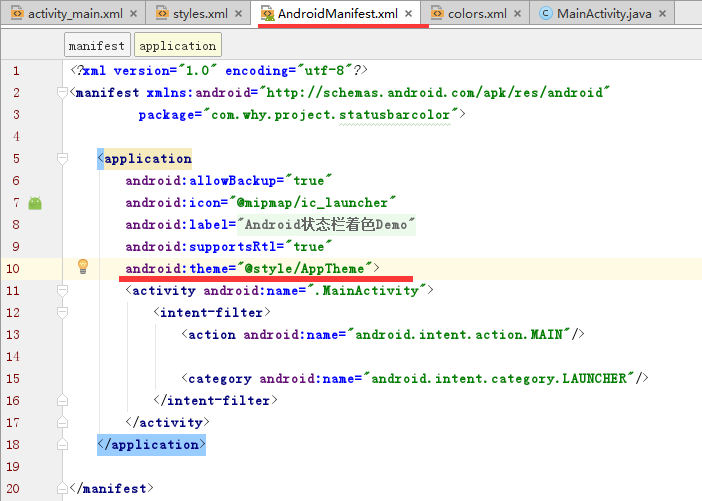
而本文想要实现的效果是在API>19和API<19的机型上都兼容状态栏着色效果。
效果图
| API>19 | API =19 | API <19 |
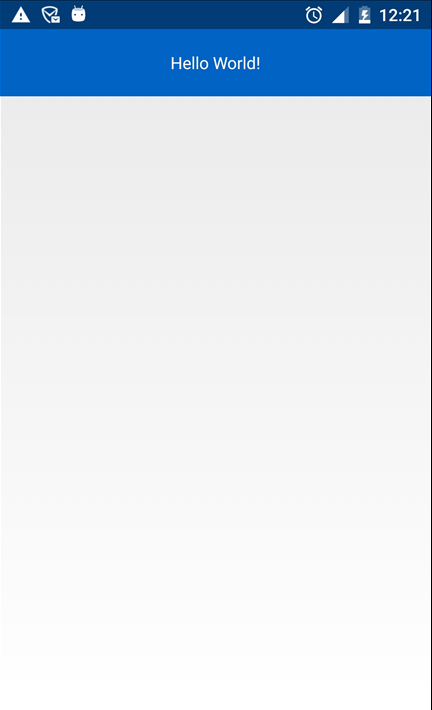
|

|

|
代码分析
- 首先将手机手机状态栏透明化
在values、values-v19、values-v21目录下分别创建相应的主题,然后在AndroidManifest.xml中给Application设置该主题。
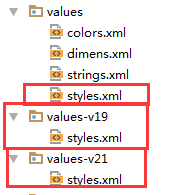
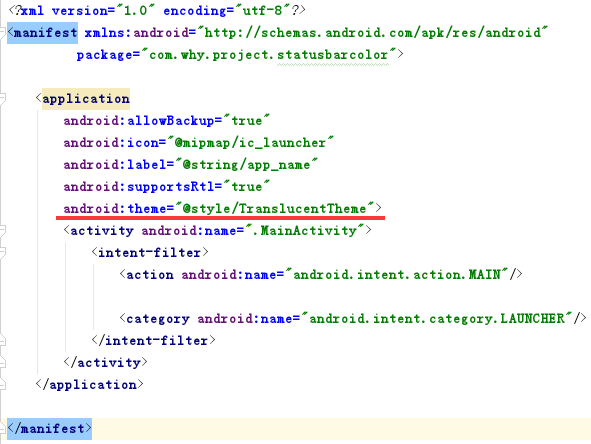
- 在布局文件中添加
android:fitsSystemWindows="true"属性
我们使用android:fitsSystemWindows="true"属性,不让布局延伸到状态栏,这时状态栏就是透明的,然后添加一个和状态栏高、宽相同的指定颜色View来覆盖被透明化的状态栏。
- 创建View并添加到状态栏
使用步骤
一、项目组织结构图
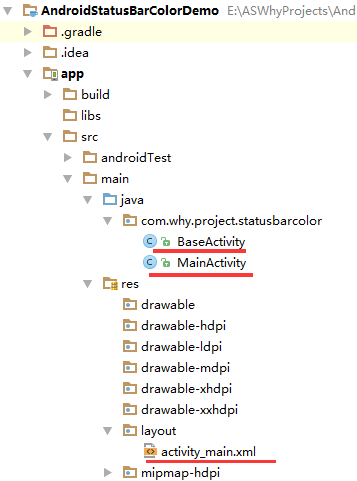

注意事项:
- 导入类文件后需要change包名以及重新import R文件路径
- values目录下的文件(strings.xml、dimens.xml、colors.xml等),如果项目中存在,则复制里面的内容,不要整个覆盖
二、使用方法
修改valus目录下的styles.xml文件【在eclipse开发环境和Android studio开发环境中建议使用不同的样式】
<resources>
<!--
Base application theme, dependent on API level. This theme is replaced
by AppBaseTheme from res/values-vXX/styles.xml on newer devices.
-->
<!--
Theme customizations available in newer API levels can go in
res/values-vXX/styles.xml, while customizations related to
backward-compatibility can go here.
-->
<!-- Eclipse开发环境 -->
<!--<style name="AppBaseTheme" parent="android:Theme.Light.NoTitleBar">
</style>-->
<!-- Android Studio开发环境 -->
<style name="AppBaseTheme" parent="Theme.AppCompat.Light.NoActionBar">
</style>
<!-- Application theme. -->
<style name="AppTheme" parent="AppBaseTheme">
<!-- All customizations that are NOT specific to a particular API-level can go here. -->
</style>
<!-- Android 状态栏着色 -->
<style name="TranslucentTheme" parent="AppTheme">
</style>
</resources>
添加\修改values-v19目录下的styles.xml文件【在eclipse开发环境和Android studio开发环境中建议使用不同的样式】
<resources>
<!--
Base application theme for API 19+. This theme completely replaces
AppBaseTheme from BOTH res/values/styles.xml and
res/values-v11/styles.xml on API 19+ devices.
-->
<!-- API 19 theme customizations can go here. -->
<!-- Eclipse开发环境 -->
<!--<style name="AppBaseTheme" parent="android:Theme.Light.NoTitleBar">
</style>-->
<!-- Android Studio开发环境 -->
<style name="AppBaseTheme" parent="Theme.AppCompat.Light.NoActionBar">
</style>
<!-- Android 状态栏着色 -->
<style name="TranslucentTheme" parent="AppTheme">
<item name="android:windowTranslucentStatus">true</item>
<item name="android:windowTranslucentNavigation">false</item>
</style>
</resources>
添加\修改values-v21目录下的styles.xml文件【在eclipse开发环境和Android studio开发环境中建议使用不同的样式】
<resources>
<!--
Base application theme for API 21+. This theme completely replaces
AppBaseTheme from BOTH res/values/styles.xml and
res/values-v11/styles.xml on API 21+ devices.
-->
<!-- API 21 theme customizations can go here. -->
<!-- Eclipse开发环境 -->
<!--<style name="AppBaseTheme" parent="android:Theme.Light.NoTitleBar">
</style>-->
<!-- Android Studio开发环境 -->
<style name="AppBaseTheme" parent="Theme.AppCompat.Light.NoActionBar">
</style>
<!-- Android 状态栏着色 -->
<style name="TranslucentTheme" parent="AppTheme">
<item name="android:windowTranslucentStatus">true</item>
<item name="android:windowTranslucentNavigation">false</item>
<item name="android:statusBarColor">@android:color/transparent</item>
</style>
</resources>
在values目录下的colors.xml文件中添加状态栏着色的颜色值代码
<?xml version="1.0" encoding="utf-8"?>
<resources>
<!-- Android 状态栏着色 -->
<color name="colorPrimary">#0164C5</color>
</resources>
在AndroidManifest.xml中给Application设置TranslucentTheme主题
<?xml version="1.0" encoding="utf-8"?>
<manifest xmlns:android="http://schemas.android.com/apk/res/android"
package="com.why.project.statusbarcolor"> <application
android:allowBackup="true"
android:icon="@mipmap/ic_launcher"
android:label="@string/app_name"
android:supportsRtl="true"
android:theme="@style/TranslucentTheme">
<activity android:name=".MainActivity">
<intent-filter>
<action android:name="android.intent.action.MAIN"/> <category android:name="android.intent.category.LAUNCHER"/>
</intent-filter>
</activity>
</application> </manifest>
在activity布局文件中的根节点元素中添加android:fitsSystemWindows="true"
<?xml version="1.0" encoding="utf-8"?>
<!-- Android 状态栏着色:android:fitsSystemWindows="true" -->
<RelativeLayout
xmlns:android="http://schemas.android.com/apk/res/android"
xmlns:tools="http://schemas.android.com/tools"
android:id="@+id/activity_main"
android:layout_width="match_parent"
android:layout_height="match_parent"
tools:context="com.why.project.statusbarcolor.MainActivity"
android:fitsSystemWindows="true"> <TextView
android:layout_width="match_parent"
android:layout_height="56dp"
android:text="Hello World!"
android:textColor="#ffffff"
android:background="@color/colorPrimary"
android:gravity="center"/>
</RelativeLayout>
在Activity基类以及子类中添加以下标记的代码
package com.why.project.statusbarcolor; import android.content.Context;
import android.os.Build;
import android.os.Bundle;
import android.support.annotation.Nullable;
import android.support.v4.content.ContextCompat;
import android.support.v7.app.AppCompatActivity;
import android.view.View;
import android.view.ViewGroup;
import android.widget.LinearLayout; /**
* Created by HaiyuKing
* Used activity基类
*/ public class BaseActivity extends AppCompatActivity{ @Override
protected void onCreate(@Nullable Bundle savedInstanceState) {
super.onCreate(savedInstanceState);
} /*==========Android 状态栏着色=============*/
public void addStatusBarView() {
int height;
height = getStatusBarHeight(this);
if (height <= 0) {
return;
}
View view = new View(this);
view.setBackgroundColor(ContextCompat.getColor(this,R.color.colorPrimary));
LinearLayout.LayoutParams params = new LinearLayout.LayoutParams(ViewGroup.LayoutParams.MATCH_PARENT, height);
ViewGroup decorView = (ViewGroup) findViewById(android.R.id.content);
decorView.addView(view, params);
} /**
* 获取状态栏的高度
* 19API以上 读取到状态栏高度才有意义
*/
public int getStatusBarHeight(Context context) {
if (Build.VERSION.SDK_INT >= Build.VERSION_CODES.KITKAT) {
int resourceId = context.getResources().getIdentifier("status_bar_height", "dimen", "android");
return resourceId > 0 ? context.getResources().getDimensionPixelSize(resourceId) : 0;
} else {
return 0;
}
}
}
package com.why.project.statusbarcolor;
import android.os.Bundle;
public class MainActivity extends BaseActivity {
@Override
protected void onCreate(Bundle savedInstanceState) {
super.onCreate(savedInstanceState);
setContentView(R.layout.activity_main);
/*==========Android 状态栏着色=============*/
addStatusBarView();
}
}
注意:
- Android studio新建的项目默认extends AppCompatActivity !如果是Eclipse开发环境则需要修改为extends Activity或者FragemntActivity或者自定义的activity基类。
- 如果activity布局中含有fragment布局,那么在Activity含有以上代码的基础上只需要在fragment布局文件中添加上android:fitsSystemWindows="true"即可
混淆配置
无
参考资料
项目demo下载地址
https://github.com/haiyuKing/AndroidStatusBarColorDemo
Android状态栏着色的更多相关文章
- Android 透明状态栏&着色状态栏
Android 5.0 及以上实现方式(android在5.0之后引入Material Design 实现方式相对简单) 透明状态栏,背景浸入状态栏 if (Build.VERSION.SDK_INT ...
- Android开发-状态栏着色原理和API版本号兼容处理
介绍 先上实际效果图,有三个版本号请注意区分API版本号 API>=20 API=19 API<19 watermark/2/text/aHR0cDovL2Jsb2cuY3Nkbi5uZX ...
- Android状态栏颜色修改
android状态栏颜色修改 状态栏颜色的修改在4.4和5.x环境下分别有不同的方式,低于4.4以下是不能修改的. 5.x环境下 方式一,状态栏将显示为纯净的颜色,没有渐变效果 /** * 状 ...
- Android状态栏透明(沉浸式效果)
Android状态栏透明(沉浸式效果) 默认效果 沉浸式效果 方式一 源码 下载地址(Android Studio工程):http://download.csdn.net/detail/q487880 ...
- Android如何着色字符串的特定部分
文章选自StackOverflow(简称:SOF)精选问答汇总系列文章之一,本系列文章将为读者分享国外最优质的精彩问与答,供读者学习和了解国外最新技术.本文探讨Android如何着色字符串的特定部分. ...
- android状态栏和NavigationBar的动态控制显示
项目在开发阅读器,阅读器对阅读界面的要求就是在工具栏不显示的状态下,ActionBar和NavigationBar都是不显示的,当工具栏显示时它们都出来,这就需要动态控制它们的显示与隐藏. 第一阶段: ...
- [Android] 状态栏的一些认识
前段时间遇到几个关于状态栏的问题,又了解了一下状态栏相关的知识,现在做一下记录. 本文地址:http://www.cnblogs.com/rossoneri/p/4316343.html 前戏和问题 ...
- android状态栏总结
针对状态栏的操作,只针对4.4kitKat(含)以上的机型,部分国产rom会失效,目前发现的有华为的EMUI Activity必须是noActionbar主题 本文基于StatusBarUtils略作 ...
- Translucent Bar Android状态栏自定义颜色
Android4.4 一个很重要的改变就是透明系统栏..新的系统栏是渐变透明的, 可以最大限度的允许屏幕显示更多内容, 也可以让系统栏和 Action Bar 融为一体, 仅仅留下最低限度的背景保护以 ...
随机推荐
- 底层网络技术以及IP编址
网络信息的传输在最底层总是依托于物理介质来进行传输的,这里的传输介质分为两种: 有线介质 导线管(导向媒体).例如:双绞线.同轴电缆.光纤等 无线介质 电磁波(非导向媒体):利用各种波长的电磁波充 ...
- bzoj 2510 弱题 矩阵乘
看题就像矩阵乘 但是1000的数据无从下手 打表发现每一行的数都是一样的,只不过是错位的,好像叫什么循环矩阵 于是都可以转化为一行的,O(n3)->O(n2)*logk #include< ...
- LOJ_2305_「NOI2017」游戏 _2-sat
LOJ_2305_「NOI2017」游戏 _2-sat 题意: 给你一个长度为n的字符串S,其中第i个字符为a表示第i个地图只能用B,C两种赛车,为b表示第i个地图只能用A,C两种赛车,为c表示第i个 ...
- [NOIP2016]愤怒的小鸟 D2 T3
Description Kiana最近沉迷于一款神奇的游戏无法自拔. 简单来说,这款游戏是在一个平面上进行的. 有一架弹弓位于(0,0)处,每次Kiana可以用它向第一象限发射一只红色的小鸟,小鸟们的 ...
- Python笔记 in 机器学习
Python3的函数实在太多了,在机器学习的过程中,总会一不留神就学到一个python的高效率用法,怕自己会忘记,所以更新在这篇随笔中. 更新至:2018.5.23 字符串str的前缀或者后缀识别 s ...
- Java报错信息 java.lang.SecurityException: Prohibited package name: java.xxx
package java.yun.System; public class SystemOut { public static void main(String[] args) { System.ou ...
- STM32标准库GPIO操作
STM32标准库GPIO操作 STM32任何外围设备的使用都分为两部分:初始化和使用.体现在代码上就是:(1)有一个初始化函数(2)main函数中的使用 1.初始化GPIO 初始化GPIO函数代码: ...
- 用 fhq_Treap 实现可持久化平衡树
支持对历史版本进行操作的平衡树 Treap 和 Splay 都是旋来旋去的 这样平衡树可持久化听起来不太好搞? 还有 fhq_Treap ! 每次涉及操作就复制一个节点出来 操作历史版本就继承它的根继 ...
- ES 19 - Elasticsearch的检索语法(_search API的使用)
目录 1 Search API的基本用法 1.1 查询所有数据 1.2 响应信息说明 1.3 timeout超时机制 1.4 查询多索引和多类型中的数据 2 URI Search的用法 2.1 GET ...
- 一大波开发者福利来了,一份微软官方Github上发布的开源项目清单等你签收
目录 微软Github开源项目入口 微软开源项目受欢迎程度排名 Visual Studio Code TypeScript RxJS .NET Core 基础类库 CNTK Microsoft cal ...
